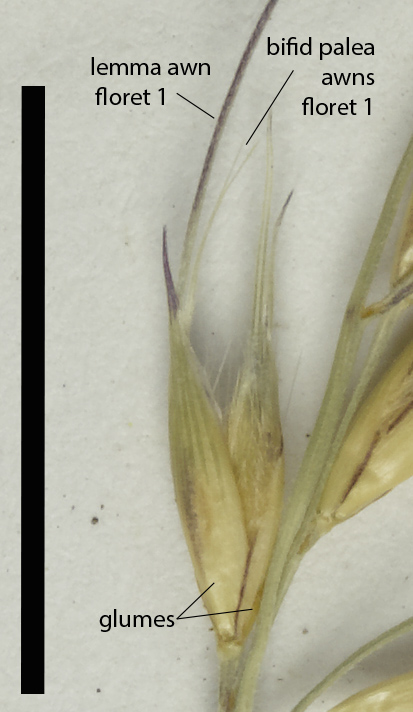Eriachne vesiculosa
Lazarides
This species occurs in Cape York Peninsula as a perennial from 30-90 cm high. Stems are usually hairless although bearded or pubescent along stem nodes or joints. Leaves are cauline (arising along the stem) and leaf blades are densely covered above with small bladder like sacs, however, sacs are only visible with a microscope. Leaf blades are up to 30 cm long and 4 mm wide, usually with long simple hairs but sometimes hairless on both surfaces, and convolute (Fig. 1). Inflorescences or flowering branches terminate the stem and are exserted from leaf axils. The inflorescences or flowering branches are open panicles with branches arising along a central stem, panicles are 5-10.5 cm long, 1-3.5 cm wide. Eriachne vesiculosa has spikelets (the basic flowering unit) consisting of two glumes encompassing two bisexual florets (modified flowers) (Fig. 2). The florets are shorter than the glumes, usually cleistogamous (self-pollinating and not opening) with the lemma of each floret giving rise to a curved awn 18-30 mm long. The palea of each floret is tapered to a point and split into 2 bristle like awns to 3 mm long.
Botanical Description
A perennial species 30-90 cm high. The culms or stems hairless, with nodes bearded, tuberculate bearded or pubescent. Leaves hairless to quite hairy; upper surface densely vesicular, blade to 30 cm long and up to 4 mm wide, convolute. The inflorescences are open panicles, 5-10.5 cm long, 1-3.5 cm wide (Fig. 1). Spikelets are defined by two glumes 6-9 mm long. The glumes encompass two bisexual florets, the florets shorter than the glumes, often cleistogamous, the lemma 4-8 mm long. The lemma of each floret is awned, the lemma awn 18-30 mm long, with the palea of each floret tapered and split into 2 bristle-like awns to 3 mm long, (Fig. 2). The lemma is hairy throughout with hairs not exceeding the apex, and with two grooves present.
Diagnostic Features
Eriachne vesiculosa is one of many species of Eriachne characterised by long awned spikelets, the awns curled, curved or bent. Other long awned species of Eriachne which occur in the region and may be easily confused with this species are E. armittii, E. burkittii, E. glauca, E. squarrosa, E. stipacea and E. rara. Some of these species are more easily distinguished than others. Most are treated in this guide, however some of the key differences between the species are shown in Table 1. In other regions of Australia e.g. the Northern Territory, additional species may also need to be considered. Eriachne vesiculosa is distinguished by the combination of the following characters, tightly convolute leaf blades with a dense covering of bladder like sacs on the upper surface, the florets shorter than the glumes and often cleistogamous, grooves present on the lemma and the palea apex split into two awns. Users are encouraged to consult Lazarides (2005) or Simon & Alfonso (2011) for more detail on distinguishing between these species.
Natural Values
This species is likely to provide seed for granivorous or seed eating animals.
Habitat
This species occurs north of the Gulf Development Road in Queensland and is known from a few scattered records in the Northern Territory around Borroloola and Kakadu. Found in wet areas, especially damp and seasonally flooded, often shaded sites, such as the channels and banks of watercourses, stream lines and grassy swamps. Growing usually in deep sandy often whitish soils (Lazarides 2005, Simon 2011).
Land Management Notes
Species of this genus are considered generally to be of low forage value (Lazarides 2002).

Resources
AVH (2017) Australia’s Virtual Herbarium, Council of Heads of Australasian Herbaria, <http://avh.chah.org.au>, accessed 30 May 2017.
Lazarides, M. (1995) The genus Eriachne (Eriachneae, Poaceae). Australian Systematic Botany 8(3): 355-452.
Lazarides, M. (2002) Economic attributes of Australian grasses. Flora of Australia 43: 213-245.
Lazarides, M., Weiller, C.M. & McCusker, A. in Mallett, K. (ed.) (2005) Eriachne. Flora of Australia 44B: 132-175.
Simon, B.K. & Alfonso, Y. (2011) AusGrass2, http://ausgrass2.myspecies.info/ accessed on [20 March 2017].

